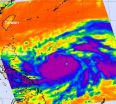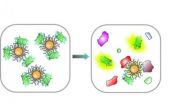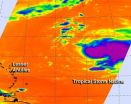(Press-News.org) In a study published today in The American Naturalist, a group of scientists led by the Zoological Society of London (ZSL) have used a technique developed to study human consumer choices to investigate what influences a baboon's foraging decisions. The technique, known as discrete choice modelling, has rarely been used before in animal behaviour research. It showed how baboons not only consider many social and non-social factors when making foraging decisions, but also how they change these factors depending on their habitat and their own social traits.
Over a six month period in Tsaobis Leopard Park in Namibia, ZSL scientists followed troops of chacma baboons (Papio ursinus) on foot from dawn to dusk. They recognised individual baboons by distinguishing features, and closely observed both the aggressive and friendly social relationships between baboons, noting which food patch they foraged in and who they foraged with. As expected, baboons were more likely to use patches containing more food. More interestingly, they also paid attention to their social relationships with other baboons in the patches.
Harry Marshall, from ZSL and Imperial College London conducted the research. He says: "More dominant baboons preferred using patches containing animals who they were dominant to, and so more likely to be able to steal food from. However, these less dominant baboons seemed to compensate for this by preferring patches containing animals with whom they had good social bonds and so were more likely to tolerate them."
ZSL's Dr Guy Cowlishaw added: "These findings show how animals' decision-making can be dependent on where they are and who they are. This suggests that some animals can change their behaviour to adjust to a changing environment."
Scientists at ZSL will continue working with collaborators and use the findings from this study to help them investigate how baboons' foraging behaviour is affected by changes in the environment, and the impact this will have on socially foraging species in the future.
### Editors' Notes
Images and B-Roll
High resolution images available here: https://zslondon.sharefile.com/d/sc6d7d0c897a49e7b
HD B-roll available here: https://zslondon.sharefile.com/d/s0b82b83df9a4b45b
Media Information
For more information please contact Smita Chandra on 0207 449 6288 or email smita.chandra@zsl.org
ZSL
Founded in 1826, the Zoological Society of London (ZSL) is an international scientific, conservation and educational charity: the key role is the conservation of animals and their habitats. The Society runs ZSL London Zoo and ZSL Whipsnade Zoo, carries out scientific research in the Institute of Zoology and is actively involved in field conservation in over 50 countries worldwide. For further information please visit www.zsl.org
ZSL Tsaobis Baboon Project
The Tsaobis Baboon Project is long term-study of the chacma baboon (Papio ursinus) population at Tsaobis Leopard Park, Namibia. It aims to use this baboon population to answer fundamental questions in behavioural and population ecology and, where appropriate, use these findings to inform conservation and management. The Project has been running since 2000 in affiliation with the Gobabeb Desert Research Foundation, Namibia and with the kind permission of the Namibian government.
Collaborating organisations
Imperial College London
Consistently rated amongst the world's best universities, Imperial College London is a science-based institution with a reputation for excellence in teaching and research that attracts 14,000 students and 6,000 staff of the highest international quality. Innovative research at the College explores the interface between science, medicine, engineering and business, delivering practical solutions that improve quality of life and the environment - underpinned by a dynamic enterprise culture.
Since its foundation in 1907, Imperial's contributions to society have included the discovery of penicillin, the development of holography and the foundations of fibre optics. This commitment to the application of research for the benefit of all continues today, with current focuses including interdisciplinary collaborations to improve global health, tackle climate change, develop sustainable sources of energy and address security challenges.
In 2007, Imperial College London and Imperial College Healthcare NHS Trust formed the UK's first Academic Health Science Centre. This unique partnership aims to improve the quality of life of patients and populations by taking new discoveries and translating them into new therapies as quickly as possible.
Website: www.imperial.ac.uk
Twitter: www.twitter.com/imperialspark
Podcast: www.imperial.ac.uk/media/podcasts
Foraging baboons are picky punters
Baboon foraging choices depend on their habitat and social status
2012-09-14
ELSE PRESS RELEASES FROM THIS DATE:
Children's intensive care units performing well despite low staffing levels
2012-09-14
Standards of care in children's intensive care units come under scrutiny in a new audit report published today by the University of Leeds and the University of Leicester.
The report, commissioned by the Healthcare Quality Improvement Partnership and carried out by the Paediatric Intensive Care Audit Network (PICANet) showed that death rates in children's intensive care units are low and continue to fall. However, there continues to be a higher risk of mortality for children of south Asian origin observed in earlier years.
This national audit also found that only 5 children's ...
Sharing the research on car-sharing
2012-09-14
Montreal, September 13, 2012 – Share and share alike is a concept we all learn as youngsters. Of course, when it comes to something as personal – and expensive – as a car, sharing's not so easy. Due to rising fuel costs hitting hard, increased concerns about the environment and overcrowded cities, car-sharing services like Communauto are becoming a popular way to get around. Can they be more popular still?
Researchers from the Concordia Institute of Information Systems Engineering can answer this question with a resounding "yes." They have piloted a computer model that ...
Do SAT scores help or hurt in decisions about who will do well in college?
2012-09-14
Every year, nervous high school juniors and seniors, clutching #2 pencils and armed with hours of test preparation, sit down and take the SAT. At their most basic, these tests focus on verbal, math, and writing ability, and performance on these tests has been linked to subsequent academic performance. As a result, college admissions teams use SAT scores along with other information, such as high school grades, in choosing their incoming freshman classes.
It is perhaps no surprise, then, that the SAT has been the subject of much scrutiny. Some researchers have asserted ...
Kids with food allergies can fall through the cracks
2012-09-14
CHICAGO --- More can be done to properly manage the care of American children with food allergies, especially when it comes to diagnostic testing and recognizing non-visual symptoms of severe allergic reactions, according to a new Northwestern Medicine study.
"Every child with a food allergy should be diagnosed by a physician, have access to life-saving medication such as an epinephrine autoinjector and receive confirmation of the disease through diagnostic testing," said lead author Ruchi Gupta, M.D., an associate professor of pediatrics at Northwestern University Feinberg ...
Honestly? Just sign here -- first
2012-09-14
Toronto – Tax collectors and insurance agencies trying to boost honest reporting could improve compliance simply by asking people to sign their forms at the beginning instead of at the end.
That's because attesting to the truthfulness of the information before a form is filled out tends to activate people's moral sense, making it harder for them to fudge their numbers after, says a new paper.
"Based on our previous research we knew that an honour code is useful, but we were wondering how much the location mattered," says Nina Mazar, an assistant professor of marketing ...
NASA sees Sanba become a super typhoon
2012-09-14
Tropical Storm Sanba exploded in intensity between Sept. 12 and 13, becoming a major Category 4 Typhoon on the Saffir-Simpson Scale. NASA's Aqua satellite captured infrared data that showed a large area of powerful thunderstorms around the center of circulation, dropping heavy rain over the western North Pacific Ocean.
NASA's Aqua satellite passed over Super Typhoon Sanba on Sept. 13 at 0447 UTC (12:47 a.m. EDT). The Atmospheric Infrared Sounder (AIRS) instrument captured an infrared image of Sanba and found an eye about 20 nautical miles (23 miles/37 km) wide, surrounded ...
UMass Amherst chemists develop nose-like sensor array to 'smell' cancer diagnoses
2012-09-14
AMHERST, Mass. – In the fight against cancer, knowing the enemy's exact identity is crucial for diagnosis and treatment, especially in metastatic cancers, those that spread between organs and tissues. Now chemists led by Vincent Rotello at the University of Massachusetts Amherst have developed a rapid, sensitive way to detect microscopic levels of many different metastatic cell types in living tissue. Findings appear in the current issue of the journal ACS Nano.
In a pre-clinical non-small-cell lung cancer metastasis model in mice developed by Frank Jirik and colleagues ...
'Smart growth' strategies curb car use, greenhouse gas emissions, SF State study suggests
2012-09-14
A new study finds that smart growth approaches to urban planning could substantially reduce the number of miles that residents drive in a year. The research was published this week in The B.E. Journal of Economic Analysis and Policy.
Smart growth focuses on the development of compact, walkable cities with houses and jobs located close together. By shortening residents' commutes, this form of urban design aims to cut transportation-related energy use and greenhouse gas emissions. California is already pursuing smart growth in order to meet emissions reductions set by the ...
NASA sees wind shear battering Tropical Storm Nadine
2012-09-14
Tropical Storm Nadine is struggling against wind shear and some dry air. Infrared satellite imagery from NASA showed that Nadine's most powerful thunderstorms were being pushed east of the center.
NASA's Aqua satellite passed over Tropical Storm Nadine early on Sept. 13 and saw several factors that indicated the storm was still struggling to achieve hurricane status.
Infrared data from the Atmospheric Infrared Sounder (AIRS) that flies aboard Aqua found the strongest thunderstorms with very cold cloud temperatures (colder than -63F/-52C) were being pushed east of Nadine's ...
Warmer temperatures make new USDA plant zone map obsolete
2012-09-14
Gardeners and landscapers may want to rethink their fall tree plantings. Warming temperatures have already made the U.S. Department of Agriculture's new cold-weather planting guidelines obsolete, according to Dr. Nir Krakauer, assistant professor of civil engineering in The City College of New York's Grove School of Engineering.
Professor Krakauer developed a new method to map cold-weather zones in the United States that takes rapidly rising temperatures into account. Analyzing recent weather data, he overhauled the Department of Agriculture's latest plant zone map released ...
LAST 30 PRESS RELEASES:
Making lighter work of calculating fluid and heat flow
Normalizing blood sugar can halve heart attack risk
Lowering blood sugar cuts heart attack risk in people with prediabetes
Study links genetic variants to risk of blinding eye disease in premature infants
Non-opioid ‘pain sponge’ therapy halts cartilage degeneration and relieves chronic pain
AI can pick up cultural values by mimicking how kids learn
China’s ecological redlines offer fast track to 30 x 30 global conservation goal
Invisible indoor threats: emerging household contaminants and their growing risks to human health
Adding antibody treatment to chemo boosts outcomes for children with rare cancer
Germline pathogenic variants among women without a history of breast cancer
Tanning beds triple melanoma risk, potentially causing broad DNA damage
Unique bond identified as key to viral infection speed
Indoor tanning makes youthful skin much older on a genetic level
Mouse model sheds new light on the causes and potential solutions to human GI problems linked to muscular dystrophy
The Journal of Nuclear Medicine ahead-of-print tip sheet: December 12, 2025
Smarter tools for peering into the microscopic world
Applications open for funding to conduct research in the Kinsey Institute archives
Global measure underestimates the severity of food insecurity
Child survivors of critical illness are missing out on timely follow up care
Risk-based vs annual breast cancer screening / the WISDOM randomized clinical trial
University of Toronto launches Electric Vehicle Innovation Ontario to accelerate advanced EV technologies and build Canada’s innovation advantage
Early relapse predicts poor outcomes in aggressive blood cancer
American College of Lifestyle Medicine applauds two CMS models aligned with lifestyle medicine practice and reimbursement
Clinical trial finds cannabis use not a barrier to quitting nicotine vaping
Supplemental nutrition assistance program policies and food insecurity
Switching immune cells to “night mode” could limit damage after a heart attack, study suggests
URI-based Global RIghts Project report spotlights continued troubling trends in worldwide inhumane treatment
Neutrophils are less aggressive at night, explaining why nighttime heart attacks cause less damage than daytime events
Menopausal hormone therapy may not pose breast cancer risk for women with BRCA mutations
Mobile health tool may improve quality of life for adolescent and young adult breast cancer survivors
[Press-News.org] Foraging baboons are picky puntersBaboon foraging choices depend on their habitat and social status


